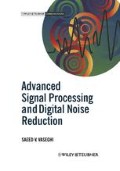Abstract
Wiener theory, formulated by Norbert Wiener, forms the foundation of data-dependent linear least squared error filters. Wiener filters play a central role in a wide range of applications such as linear prediction, signal coding, echo cancellation, signal restoration, channel equalisation, system identification etc. The coefficients of a Wiener filter are calculated to minimise the average squared distance between the filter output and a desired signal. In its basic form, the Wiener theory assumes that the signals are stationary processes. However, if the filter coefficients are periodically recalculated, for every block of N samples, then the filter adapts to the average characteristics of the signals within the blocks and becomes block-adaptive. A block-adaptive filter can be used for signals that can be considered stationary over the duration of the block. In this chapter we study the theory of Wiener filters, and consider alternative methods of formulation of the Wiener filter problem. We consider the application of Wiener filters in channel equalisation, time-delay estimation, and additive noise suppression. A case study of the frequency response of a Wiener filter, for additive noise reduction, provides useful insight into the operation of the filter. We also deal with some implementation issues of Wiener filters.
Access this chapter
Tax calculation will be finalised at checkout
Purchases are for personal use only
Preview
Unable to display preview. Download preview PDF.
Bibliography
Akaike H. (1974), A New Look at Statistical Model Identification, IEEE Trans, on Automatic Control, AC-19 Pages 716–23, Dec.
Alexander S.T. (1986), Adaptive Signal Processing Theory and Applications. Springer-Verlag, New York.
Anderson B.D., Moor J.B. (1979) Linear Optimal Control, Prentice-Hall, Englewood Cliffs, N. J.
Bjorck A. (1967), Solving Linear Least Squares Problems by Gram-Schmidt Orthogonalisation, BIT, Vol. 7, Pages 1–21.
Dorny C.N. (1975), A Vector Space Approach to Models and Optimisation, Wiley, New York.
Durbin J. (1959), Efficient Estimation of Parameters in Moving Average Models, Biometrica Vol. 46, Pages 306–16.
Giordano A.A., Hsu F.M. (1985), Least Square Estimation with Applications to Digital Signal Processing, Wiley, New York.
Givens W. (1958), Computation of Plane Unitary Rotations Transforming a General Matrix to Triangular Form, SIAM J. Appl. Math. Vol. 6, Pages 26–50.
Golub G.H., Reinsch (1970), Singular Value Decomposition and Least Squares Solutions, Numerical Mathematics, Vol. 14, Pages 403–20.
Golub G.H., Van Loan C.F. (1983). Matrix Computations, Johns Hopkins University Press, Baltimore, MD.
Golub G.H., Van Loan C.F. (1980). An Analysis of the Total Least Squares Problem, SIAM Journal of Numerical Analysis, Vol. 17, Pages 883–93.
Halmos P. R. (1974), Finite-Dimensional Vector Spaces. Springer-Verlag, New York.
Haykin S. (1991), Adaptive Filter Theory, 2nd Edition, Prentice-Hall, Englewood Cliffs, N. J.
Householder A.S. (1964), The Theory of Matrices in Numerical Analysis, Blaisdell, Waltham, Mass.
Kailath T. (1974), A View of Three Decades of Linear Filtering Theory, IEEE Trans. Information Theory, Vol. IT-20, Pages 146–81.
Kailath T. (1977), Linear Least Squares Estimation, Benchmark Papers in Electrical Engineering and Computer science, Dowden, Hutchinson &Ross.
Kailath T. (1980), Linear Systems, Prentice-Hall, Englewood Cliffs, N. J.
Klema V.C., Laub A. J. (1980), The Singular Value Decomposition: Its Computation and Some Applications, IEEE Trans. Automatic Control, Vol. AC-25, Pages 164–76.
Kolmogrov A.N. (1939), Sur 1’ Interpolation et Extrapolation des Suites Stationaires, Comptes Rendus de l’Academie des Sciences, Vol. 208, Pages 2043–45.
Lawson C.L., Hanson R.J. (1974), Solving Least Squares Problems, Prentice-Hall, Englewood Cliffs, N. J.
Orfanidis S. J. (1988), Optimum Signal Procesing: An introduction, 2nd Edition, Macmillan, New York.
Scharf L.L. (1991), Statistical Signal Processing: Detection, Estimation, and Time Series Analysis, Addison Wesley, Reading, Mass.
Strang G.(1976), Linear Algebra and Its Applications, 3rd ed., Harcourt Brace Jovanovich, San Diego, California.
Wiener N. (1949), Extrapolation, Interpolation and Smoothing of Stationary Time Series, MIT Press Cambridge, Mass.
Wilkinson J. H. (1965), The Algebraic Eigenvalue Problem, Oxford University Press, Oxford.
Whittle P.W. (1983), Prediction and Regulation by Linear Least-Squares Methods, University of Minnesota Press, Minneapolis, Minnesota.
Wold H., (1954), The Analysis of Stationary Time Series, 2nd ed. Almquist and Wicksell, Uppsala, Sweden.
Author information
Authors and Affiliations
Rights and permissions
Copyright information
© 1996 John Wiley & Sons Ltd. and B.G. Teubner
About this chapter
Cite this chapter
Vaseghi, S.V. (1996). Wiener Filters. In: Advanced Signal Processing and Digital Noise Reduction. Vieweg+Teubner Verlag. https://doi.org/10.1007/978-3-322-92773-6_5
Download citation
DOI: https://doi.org/10.1007/978-3-322-92773-6_5
Publisher Name: Vieweg+Teubner Verlag
Print ISBN: 978-3-322-92774-3
Online ISBN: 978-3-322-92773-6
eBook Packages: Springer Book Archive

